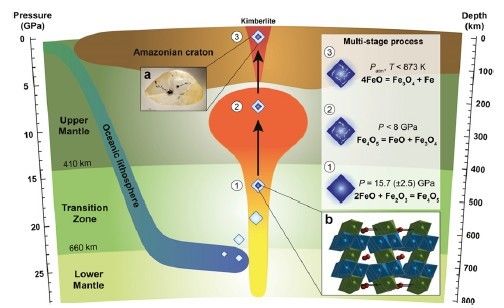
Discovering the Chemistry and Mineralogy of the Earth's interior through the study of super-deep Diamonds
Decades of experimental studies in petrology and mineralogy have led to the discovery of important minerals consisting mostly of magnesium, iron, silicon and oxygen (wadsleyite, ringwoodite, bridgmanite and ferropericlase) and considered to be representative of the mineralogical composition of the planet at depths greater than 400 km.
Lab simulations of the primordial conditions of pressure (on average up to 250000 atmospheres) and temperature (1600-2200 °C) demonstrated that these minerals were among the first to form as the Earth's core - an alloy of iron and nickel - solidified as a result of the cooling of the magma ball that formed our planet more than 4.5 billion years ago. Yet, the chemical composition of the Earth's interior is still little known, due to the scarce and complex direct "observations" of the minerals trapped in what is now the matter coming from the deepest depths of the Earth, the diamond.
Today a new international study coordinated by Chiara Anzolini of the University of Padua, with the collaboration of Vincenzo Stagno of the Department of Earth Sciences of Sapienza, has analysed very rare super-deep diamonds, discovering some micro-inclusions of minerals containing iron at different oxidation states (metallic, ferrous and ferric iron).
"The inclusions of minerals present inside the diamond - says Vincenzo Stagno - containing iron with various states of oxidation, suggest the occurrence of a deep chemical disturbance, known as redox front, due to the interaction of the Earth's mantle with more oxygenated portions, probably due to the process of terrestrial subduction. It is precisely in these portions that minerals discovered in the laboratory but considered rare or unknown may crystallise".
Moreover, when portions of the crust rich in oxygen reach the depths, they trigger chemical reactions. On the one hand, they cause the iron contained in the minerals present to rust and on the other make the formation of diamonds possible, showing how dynamic the Earth is inside. In short, diamonds are just the result of carbon precipitation following the oxygen depletion by iron-rich minerals.
The researchers deciphered a sequence of ferriferous minerals in the super-deep diamond and discovered, thanks to the analysis of the volumetric ratios of the different elements, that their formation is linked to the decomposition of a mineral the chemical formula of which could only be Fe4O5. The discovery of a mineral like Fe4O5 opens up new scenarios regarding the chemical and mineralogical composition of the Earth's deep mantle and serves as an inspiration for further experimental studies.
"Iron oxide ores are highly studied in most scientific disciplines because they directly influence planetary evolution, life and technology due to their magnetic properties. Just think - Chiara Anzolini and Vincenzo Stagno point out - about the formation of the Earth's core, the use of iron in ancient times, and the use of magnets".
This study shows how important information about the chemical and mineralogical composition of the Earth's interior comes from the careful study of rare super-deep diamonds.
"The main purpose of geology is to understand the chemical and mineralogical composition of our planet from the surface to its great depths through both the study of natural rocks and experimentally reproduced minerals", concludes Stagno - "To this end, I have been setting up the Geology of Diamonds class for a couple of years now, which in addition to providing notions of cutting-edge experimental techniques illustrates to students a more recent view of the nature of the Earth's interior. In short, a new journey to the centre of the Earth".
References:
Evidence for complex iron oxides in the deep mantle from FeNi(Cu) inclusions in superdeep diamond - Chiara Anzolini, Katharina Marquardt, Vincenzo Stagno, Luca Bindi, Daniel J. Frost, D. Graham Pearson, Jeffrey W. Harris, Russell J. Hemley, Fabrizio Nestola - PNAS 2020 https://doi.org/10.1073/pnas.2004269117
Further Information
Vincenzo Stagno
Department of Earth Sciences
vincenzo.stagno@uniroma1.it
